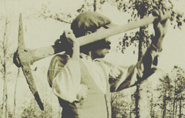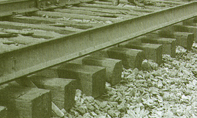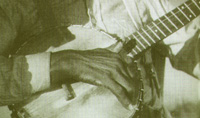| |
Hear Music |
Read Lyrics |
Analyze the Music
Analysis of John Henry Music
Guy Johnson, in his definitive
1928 study, calls John Henry "the Negro's greatest folk character." Which
is why the facts of John Henry's literal life - as a black man trying to
work his way through a "reconstructed" South - are only incidental to the
countless versions of his story passed down over a century.
A hero becomes what you need.  So
in the ballad, John Henry's makeup depends on who is telling his tale.
Is he a strong, black man driving the railroad west? A husband and father?
A sweaty, sexual dynamo swinging the hammer? A symbol of futility because
he died on the job or an inspiration because he beat the white man's steam-drill? So
in the ballad, John Henry's makeup depends on who is telling his tale.
Is he a strong, black man driving the railroad west? A husband and father?
A sweaty, sexual dynamo swinging the hammer? A symbol of futility because
he died on the job or an inspiration because he beat the white man's steam-drill?
Considering that John Henry did
clearly exist - and that we know the color of his skin - it's surprising
how rarely his race is mentioned. A Tennessee version, found in Johnson's
book, opens with a description of John Henry as a "coal black man." And
Leon R. Harris, of Moline, Illinois, told Johnson that in his version,
heard for the first time in 1894, John Henry and his hammer took on a white
man and his steam drill.
Otherwise, it's likely that the
black singers, whether prisoners or blues men, took his race as a given,
seeing no need to mention it. He is their Paul Bunyon. In the case of Johnny
Cash, race had nothing to do with the ballad. This was a union song, not
a civil rights anthem. After all, John Henry, as ultimate working-class
hero, has been embraced by disparate groups: black prisoners, white mountain
musicians, college folk revivalists, elderly blues singers. Most Southern
states have claimed him, as does Maine in Woody Guthrie's version, even
though he was likely born in North Carolina or West Virginia.
The connector is this valiant battle,
man against machine, man against boss, man against the power structure
that keeps his people (African-Americans? Laborers?) in chains. He's a
hero to Woody Guthrie, a warning to Mississippi John Hurt, an inspiration
to the chain gang. From verse-to-verse, generation-to-generation, the story
changes to suit the singer. The name and steel-driving solitude stay the
same.
 As
far as authenticity, there's really no better moment than that recorded
in 1947 AT THE
MISSISSIPPI STATE PENITENTIARY at Parchman. In the melodies of the
ballad, Alan Lomax writes, "the African slave, transformed into steel-driving
John Henry, put the Bill of Rights into one phrase: A man ain't nothing
but a man." As
far as authenticity, there's really no better moment than that recorded
in 1947 AT THE
MISSISSIPPI STATE PENITENTIARY at Parchman. In the melodies of the
ballad, Alan Lomax writes, "the African slave, transformed into steel-driving
John Henry, put the Bill of Rights into one phrase: A man ain't nothing
but a man."
These guys take their hero seriously,
to the point that a prisoner named Bama questions the opening stanza. How
could, he asks, a baby who "you could hold in the palm of your hand" also
be "drivin' steel like a man" at nine days old?
If only Bama had heard Arthur Bell's
version, recorded eight years earlier at Arkansas' CUMMINS
STATE FARM by Alan's father, John Lomax. Bell, over the steady thwack
of the pick, sings that it is John Henry holding his own baby in his hand.
It's hard to tell just how many
ballads, jazz riffs and blues songs made the trip North during the urban
migration of the early '20th Century. "John Henry" traveled with BIG
BILL BROONZY, who was born in Mississippi in 1893 and settled in Chicago
by the late '20s. Broonzy's "John Henry" resonates because the bluessinger,
backed by folk musician Pete Seeger, was nearing the end of his own life.
Cancer took him in August of 1958.
WOODY
GUTHRIE was the bridge between the hipster bohemia of the '50s and
the more mainstream folk revival that spread across college campuses in
the '60s. Not surprisingly, Guthrie remembers "John Henry" as a working-class
hero. Guthrie isn't sure where he's from- "Some said he's born down in
Texas," he sings, "some said he's born up in Maine. I just said he was
a Louisiana man" - but there's no question where he ended up: Leader of
a steel-driving chain gang.
In the '60s, as ballads and balladeers
were rediscovered, nobody was rediscovered quite like MISSISSIPPI JOHN
HURT. He had recorded a series of 78s in the late 1920s. When the
Depression
hit, Hurt returned to Avalon, Mississippi and worked as a sharecropper
and sang on weekends. Until 1963, that is, when two young, white blues
players from Washington sought out the man behind the finger picking.  They
found Hurt, 71 years old, ready to spend the last three years of his life
playing folk festivals and coffeehouses. Hurt's version of the ballad,
called "Spike Driver Blues," was recorded three daysafter the Christmas
of 1928 in New York City. It opens with the narrator skipping out on his
boss and handing over the hammer that killed John Henry because "it won't
kill me." They
found Hurt, 71 years old, ready to spend the last three years of his life
playing folk festivals and coffeehouses. Hurt's version of the ballad,
called "Spike Driver Blues," was recorded three daysafter the Christmas
of 1928 in New York City. It opens with the narrator skipping out on his
boss and handing over the hammer that killed John Henry because "it won't
kill me."
Thanks to Hurt, and mountain musicians
like CLARENCE
ASHLEY, who was also part of the revival, a new generation of players
spread the story of John Henry. Future Byrd ROGER
McGUINN banged out a version on his banjo at his family home in
1959.
JOHN FAHEY, a philosophy student at American University, recorded his
wordless, rambling "John Henry Variations" in 1963 and again in 1967.
Mike Seeger, a folklorist and banjo
player, discovered one other way the ballad spread across racial and geographic
divides long before field recordings and folk revivals spread the word.
He learned that LESLEY
RIDDLE, a black man in Tennessee, was one of many musicians visited
by A.P. Carter, patriarch of the Carter family. (Into which Johnny Cash
married.) In 1965, Seeger tracked down and recorded Riddle, who was working
in a barbershop in Rochester, New York.
Finally, there is JOHNNY CASH's
version of the ballad, "The Legend of John Henry's Hammer." If nothing
else, it is different. It opens with the Man in Black's disturbingly gastrointestinal
grunts and sputters on for eight-and-a-half minutes, breaking for enough
corny dialogue to make it the only version of "John Henry" fit for a game
of musical chairs.
Cash's version, for all its shortcomings,
makes an important point about the universality of the ballad. John Henry
is no longer a black man struggling to make his way through the Reconstruction.
He's a "giant of a steel driver tormented by a mine boss, challenged by
the newly invented automatic stream drill, but he goes to his death gloriously
defying both," according to the liner notes of 1962's
"Blood, Sweat And Tears." The album cover features a buff Johnny Cash
with a pick axe in his right hand.
In other words, John Henry is as
much a hero to a pill-popping rockabilly singer in Nashville, Tennessee
as a black man in the lock-up at the State Penitentiary.
This analysis was contributed by Geoff
Edgers
|

